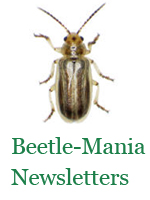This site is provided as an introduction to biological control of weeds in Texas. Basic information about the target weeds is provided. Insects and mites that have been introduced into Texas as agents for biological control of weeds are included and are the focus of this site. The use of grass carp as an agent to manage nuisance aquatic weeds is mentioned for completeness although most of the information about this agent should be acquired from Texas Parks and Wildlife. Disease organisms as agents for biological control of weeds has not been included.. There are few examples of disease organisms that have been used as biological control agents for weeds. For more information, you should review the web page links provided. The literature cited sections provide citations that will server as an introduction to the scientific literature.
Biological Control of Weeds in Texas
Texas has an interesting, although rather brief, history of involvement with biological control of weeds. Releases of insects for biological control to manage aquatic weeds in Texas began in the early 1960’s. The introduction of Agasciles hygrophila, a flea beetle, to control alligatorweed was probably the first program. This beetle can quickly build up in numbers and locally reduce alligatorweed in waterways. Few other biological control agents show such dramatic results as this beetle. Later in the 1960’s, the first releases of biological control agents management of water hyacinth resulted in establishment. Since that time additional insects have been released to manage hydrilla, and water lettuce. The introduction of grass carp into Texas waters first took place in Lake Conroe in 1981. This event and subsequent use of grass carp for biological control of aquatic weeds is probably the most visible example of biological control of weeds from a public standpoint.
Much of the basic research for biological control of aquatic weeds in the United States is conducted by the Waterways Experiment Station, Army Corps of Engineers, Vicksburg, Mississippi and the Center for Aquatic Plants, University of Florida. The Texas Parks and Wildlife Department, Texas Department of Agriculture and various other state agencies have all contributed or helped expedite biological control of weed programs in the state.
Programs for biological control of rangeland weeds in Texas centers around only a few weeds, namely; puncturevine, musk thistle, field bindweed, and salt cedar. Puncturevine weevils have contributed to the reduction of puncturevine particularly in west Texas for many years. Musk thistle has been studied in many other states and became a rather recent problem in Texas. The first releases of biological control agents against musk thistle were make in 1987 at Kerrville. Since that time redistribution efforts have established the thistle head weevil in several other counties in Texas. Recent work by Jerry Michels, Texas A&M University, has focused on the use of mites to control field bindweed. Biological control of salt cedar has been under investigation for about ten years. Permits to study caged leaf beetles outside of a quarantine facility in Texas were allowed for the first time in 1999.
Biological control of weeds in Texas has clearly been lead by Jack DeLoach, USDA-ARS at Temple. Dr. DeLoach has been the leader on the salt cedar project. Foreign exploration and research by Jack has contributed to both rangeland weeds and several aquatic weeds. Jack has also contributed studies on prickly pear and mesquite, both of which were not selected for active biological control programs in Texas because of alternate uses of these plants. Paul Boldt, now retired from the Temple station, was the early investigator who studied the insects for biological control of musk thistle and its relatives in the Mediterranean region before they were released in the United States.
Another Angle
Another important role Texas has played is that of providing biological control agents to manage weeds in other parts of the world and research to support such programs. For example, prickly pear cactus had become a problem weed in the 1920’s after it was imported into Australia. Biological control of prickly pear was an option for management that was relatively low cost and had the potential for a permanent solution. Consequently, Australians came to Texas and New Mexico to investigate the insect fauna of prickly pear. A considerable research program was conducted investigating the local insects. This project eventually lead to the importation of the Cactoblastis moth from South America into Australia. Caterpillars of the moth feed on the cactus pads and the damaged pads are susceptible to diseases that can also contribute to the demise of the plant. Since this moth became established in Australia, prickly pear infestations have been dramatically reduced which resulted in a major success for biological control.
A Final Note
The western states in particular have biological control programs for many weeds that are not known to occur in Texas or are not considered pests here. Examples of such weeds, include leafy spurge, klamath weed, purple loosestrife, yellow star thistle, and dalmation toadflax. Texas remains fortunate to have avoided infestations of these weeds.

